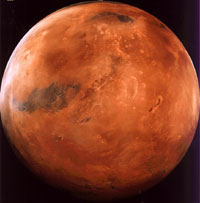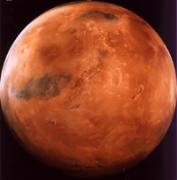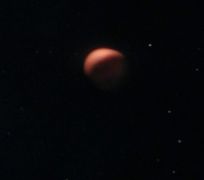Mars
| Official Name | United Martian Colonies[1] (founded 2103)[2] |
| Affiliation | United Earth Republic,[3] United Federation of Planets[4] |
| Astrography | Sol IV,[4] Sol Sector, Alpha Quadrant[5] |
| Distance from Primary | 227,940,000km[5] |
| Orbital Period | 686.9 days[5] |
| Rotational Period | 24 hours, 37 minutes[5] |
| Class | M (Terraformed from Class K)[6][5][3] |
| Surface Temperature | -120°C to 25°C[5] |
| Diameter | 6790km[5] |
| Gravity | 0.38g[5] |
| Natural Satellites | Phobos, Deimos[3][7] |
| Points of Interest | Utopia Planitia Fleet Yards,[8] Olympus Mons, Valles Marineris[5] |
| Notable Species | Humans[1] |
| Notable Individuals | Mira Romaine,[9] Simon Tarses[10] |
| Notable Events |
Originally a Class K planet,[5] Mars was terraformed over the course of two centuries to become Class M.[6][7][5] Mars is the fourth planet in the Sol system,[4] located in the Sol Sector[5] (aka Sector 001)[11] of the Alpha Quadrant.[5]
The first Human settlers arrived on Mars in 2103.[2] The colony's original flag was based on a painting of a bullfighter on velvet.[5] In 2105, a serial murderer killed eight women, and the crime would go unsolved until 2266.[12]
Mira Romaine[9] and Simon Tarses[10] were both born on Mars. Leah Brahms resided on Mars while working on the Galaxy class starship project at Utopia Planitia Fleet Yards.[8]
Environment & Geography
By 2155, the terraforming of Mars was well underway, and only thermal insulation gear and simple breathing masks were needed to venture onto the planet's surface, rather than full environmental suits.[3] By the 24th century, Mars had been completely terraformed.[6] Only 10% of Mars' surface is covered by water, nearly all of which is in freshwater lakes created from existing impact craters.[13]
One of Mars' most famous features is Olympus Mons, an extinct volcano and the tallest mountain in the Sol system. Another notable feature is Valles Marineris, a network of steep canyons that stretches for 4000 kilometers. Hellas Mare is a huge freshwater lake in the southern hemisphere created from Mars' largest impact crater, Hellas Planitia.[13]
History
Human settlement began in 2103,[2] when the first permanent colony was established on the plains of Utopia Planitia. Established by the United Space Probe Agency, the settlement was called Nova Ares and its first inhabitants were mostly UESPA support personnel who oversaw ship launches and refueling.[13] Some of these early settlers included ancestors of Jean-Luc Picard.[14]
The first Humans to settle Mars adopted the term "Martians" in jest. Every year, they organized the H.G. Wells Martian Festival, named in honor of the author of "War of the Worlds," though the festival became more of a curiousity by the 24th century. As the Martian independence movement gained momentum in the mid-22nd century, the residents of Mars took the term more seriously, and it became a symbol of their desire to govern themselves. As the colony grew, it attracted free spirits who just wanted to live on Mars. Settlement had spread beyond Utopia Planitia, and the colonists were sufficiently numerous and confident of themselves that a momement for independence began to form.[13]
In 2152, informal groups of activists coalesced to form the 100-member Mars Constituent Assembly,[13] which published a document called the "Fundamental Declaration of the Martian Colonies,"[1] which asserted that the Mars colonists were entitled to the same political and legal rights as anyone living on Earth. The question of what to do with Mars became even more troublesome when war broke out with the Romulan Star Empire in 2155. With the war raging, Earth authorities and the Mars Constitutent Assembly approved an arrangement in 2158 in which Mars would retain its allegiance to Earth, while the colonists would gain considerable authority to govern themselves. The formation of the United Federation of Planets in 2161 rendered any remaining controversy over Martian independence moot.[13]
In 2230, Starfleet expanded the old fleet support bases and built the Utopia Planitia Fleet Yards around them.[13] The Utopia Planitia yards quickly became one of Starfleet's most important construction and support facilities and the birthplace of some of its most famous vessels, including the U.S.S. Enterprise NCC-1701-D,[15] the U.S.S. Defiant NX-74205,[16] and the U.S.S. Voyager NCC-74656.[17]
By the 24th century, Nova Ares had become a thriving city of 100,000 residents. The Mars Elective Assembly meets in a conference hall built on the site of the first meeting of the Assembly in 2147. The tallest structure in Nova Ares is a sleek, 100-story skyscraper that houses the headquarters of Dennis Young Amalgamated Industries, the largest private corporation on Mars.[13]
Notes and References
- ↑ Jump up to: 1.0 1.1 1.2 Roddenberry, Gene (Executive Producer). "Court Martial." Star Trek, Season 1, Episode 20 (Production 15). Directed by Marc Daniels. Story by Don M. Mankiewicz. Teleplay by Don M. Mankiewicz and Steven W. Carabatsos (Teleplay). Desilu Productions, 2 February 1967.
- ↑ Jump up to: 2.0 2.1 2.2 Berman, Rick & Piller, Michael & Taylor, Jeri (Executive Producers). "The 37s." Star Trek: Voyager, Season 2, Episode 1. Directed by Conway, James L. Written by Jeri Taylor & Brannon Braga. Paramount Pictures Corporation, 28 August 1995.
- ↑ Jump up to: 3.0 3.1 3.2 3.3 Berman, Rick et al (Executive Producers). "Demons". Star Trek: Enterprise, season 4, episode 20 (Production number 96). Directed by LeVar Burton. Written by Manny Coto. Paramount Pictures. 6 May 2005.
- ↑ Jump up to: 4.0 4.1 4.2 Roddenberry, Gene (Executive Producer). "The Cage". Star Trek, season 0, episode 0 (Production number 01). Directed by Robert Butler. Written by Gene Roddenberry. Released 1986. Desilu Productions. 1965.
- ↑ Jump up to: 5.00 5.01 5.02 5.03 5.04 5.05 5.06 5.07 5.08 5.09 5.10 5.11 5.12 5.13 Mandel, Geoffrey. Star Trek: Star Charts. Pocket Books, 2002.
- ↑ Jump up to: 6.0 6.1 6.2 "Mosaic". Star Trek: Voyager. Novel. Simon & Schuster/Pocket Books, October 1996.
- ↑ Jump up to: 7.0 7.1 "Terra Prime". Star Trek: Enterprise, Episode 97. Television. Paramount Pictures Corporation, 13 May 2005.
- ↑ Jump up to: 8.0 8.1 Roddenberry, Gene & Rick Berman (Executive Producers). "Booby Trap". Star Trek: The Next Generation, season 3, episode 6 (Production number 154). Co-Executive Producer: Michael Piller. Directed by Gabrielle Beaumont. Story by Michael Wagner & Ron Roman. Teleplay by Ron Roman & Michael Piller & Richard Danus. Paramount Pictures. 30 October 1989.
- ↑ Jump up to: 9.0 9.1 Roddenberry, Gene (Executive Producer) and Freiberger, Fred (Producer). "The Lights of Zetar." Star Trek, Season 3, Episode 18. Directed by Herb Kenwith. Written by Jeremy Tarcher and Shari Lewis. Paramount Pictures Corporation, 31 January 1969.
- ↑ Jump up to: 10.0 10.1 Roddenberry, Gene et al (Executive Producers). "The Drumhead". Star Trek: The Next Generation, season 4, episode 21 (Production number 195). Directed by Jonathan Frakes. Written by Jeri Taylor. Paramount Pictures. 29 April 1991.
- ↑ Roddenberry, Gene et al (Executive Producers). "The Best of Both Worlds, Part II". Star Trek: The Next Generation, season 4, episode 1 (Production number 175). Directed by Cliff Bole. Written by Michael Piller. Paramount Pictures. 24 September 1990.
- ↑ Roddenberry, Gene (Executive Producer). "Wolf in the Fold." Star Trek, Season 2, Episode 7. Directed by Joseph Pevney. Written by Robert Bloch. Desilu Productions, 22 December 1967.
- ↑ Jump up to: 13.0 13.1 13.2 13.3 13.4 13.5 13.6 13.7 Heinig, Jess (Line Developer). Worlds. Star Trek Roleplaying Game. Decipher Book 7. Written by Eric Burns, Kenneth A. Hite, and Doug Sun. Original Art by Blake Beasley and Kieran Yanner. Decipher, Inc.. 2005.
- ↑ Berman, Rick (Producer). Star Trek: Generations. Directed by David Carson. Story by Rick Berman & Ronald D. Moore & Brannon Braga. Screenplay by Ronald D. Moore & Brannon Braga. Paramount Pictures. 18 November 1994.
- ↑ Roddenberry, Gene (Executive Producer). "Encounter at Farpoint". Star Trek: The Next Generation, season 1, episode 1-2 (Production number 101-102). Co-Executive Producers: Rick Berman & Maurice Hurley. Directed by Corey Allen. Written by D.C. Fontana & Gene Roddenberry. Paramount Pictures. 28 September 1987.
- ↑ Berman, Rick et al (Executive Producers). "The Search, Part I". Star Trek: Deep Space Nine, season 3, episode 1 (Production number 447). Directed by Kim Friedman. Story by Ira Steven Behr & Robert Hewitt Wolfe. Teleplay by Ronald D. Moore. Paramount Pictures. 26 September 1994.
- ↑ Berman, Rick & Brannon Braga (Executive Producers). "Relativity." Star Trek: Voyager, Season 5, Episode 23 (Production 218). Directed by Allan Eastman. Story by Nick Sagan. Teleplay by Bryan Fuller & Nick Sagan & Michael Taylor. Paramount Pictures, 12 May 1999.









